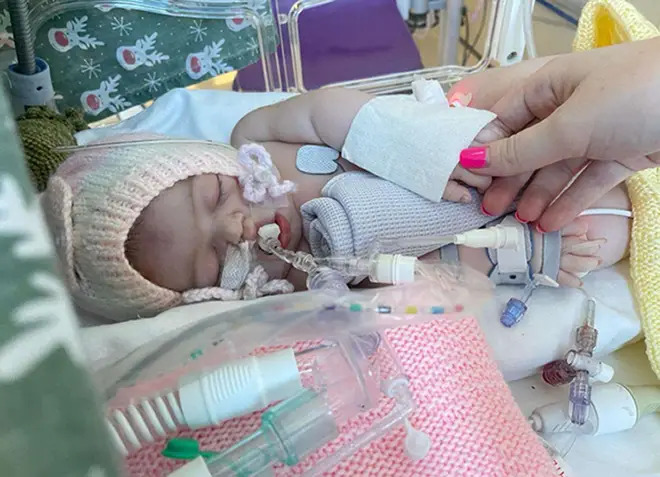Mother hails 'groundbreaking' nanodiamond treatment that could save babies born with rare condition
Amelia, underwent life-saving surgery just days after birth for severe congenital diaphragmatic hernia (CDH).

Georgia Turner’s little girl Amelia underwent life-saving surgery just days after birth for severe congenital diaphragmatic hernia (CDH). The condition, which affects one in every 3,000 babies, is potentially fatal. It occurs when a child’s diaphragm fails to develop fully, allowing organs that should sit it in the abdomen to move into the chest and crush the lungs as they grow. In the most severe cases, and when left untreated, less than 25% of babies born with CDH will survive after birth.
Georgia Turner welcomed news that scientists have developed a system to deliver treatment directly to babies in the womb using nanodiamonds.The system, which delivers a hormone that stimulates lung growth, was tested on lab-grown mini-lungs.
Researchers hope the treatment will improve outcomes for children born with severe CDH.
“New research like this is great to see how experts are trying to make the treatment for CDH more successful for all children, and less invasive. Hopefully better treatments will also prevent relapse cases like Amelia,” Ms Turner said.
Currently, treatment for severe cases involves fetal surgery, in which a balloon is placed into the baby’s windpipe to stimulate lung growth.
The procedure increases survival odds to around 50%.
Researchers said vascular endothelial growth factor (VEGF) – a hormone that supports lung development during pregnancy – is significantly reduced in babies with CDH.
The international team, led by experts at GOSH, University College London and KU Leuven in Belgium, set out to find a safe way to deliver VEGF to affected babies.
Writing in the Blue Journal (American Journal of Respiratory and Critical Care Medicine), they describe how they created a microscopic delivery system made from nanodiamonds – carbon nanoparticles smaller than the thickness of a human hair.
To test its effectiveness, the researchers developed lab-grown human mini-lungs with key features of CDH.
Using 3D printing, they compressed the lung tissue to mimic the way organs press against the lungs in babies with the condition.
As well as testing the delivery system on the mini-lungs, scientists also tested it on rats with the condition and found the treatment was “complementary” to that achieved by standard care alone.
These experiments suggest giving the VEGF delivery system at the same time as the surgical balloon procedure led to the healthiest lungs.
Research is now under way to develop a delivery system that could break down as the baby grows, and experts hope further testing could lead to the treatment becoming a reality for patients and their families within five years.
Co-lead author, Dr Stavros Loukogeorgakis, GOSH surgeon and associate professor of paediatric surgery at UCL Great Ormond Street Institute of Child Health, said: “Nanodiamonds, 3D-printing and growth hormones in the womb all sounds a bit science fiction we know, but this research is really showing us what is possible.
“As the saying goes: ‘diamonds are forever’, so we now want to create a delivery system that would break down as the baby grows, this isn’t an insurmountable problem, and we could be in a place to offer this to the first families in as little as five years.”
